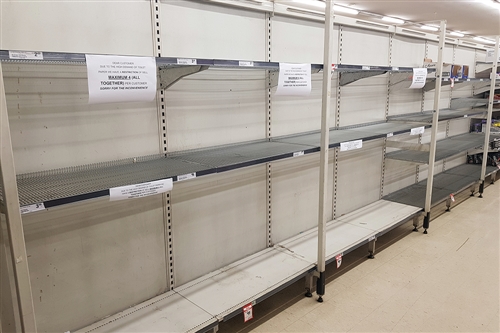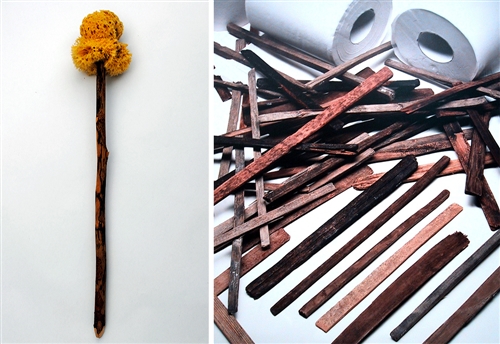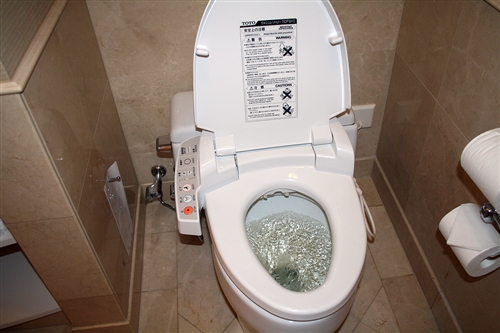By Bennett Sherry, WHP Team
Maine, USA
Life under a pandemic is serious. We're all dealing with difficult times right now. The WHP blog provides plenty of serious material on COVID-19, but we also want to leave room for levity from time to time. So keep an eye out for the occasional lighter post, where we dig into the history behind some of the more surprising human reactions to the pandemic.
This pandemic is a bummer. You’re stuck inside, dividing your attention between schoolwork, caring for your family, and seeing to the necessities of life. Some of these bare necessities have grown scarce. Perhaps the most glaring example are the gaps on store shelves where toilet paper used to be.
It’s all over the news. And I mean that literally. One Australian newspaper has even started printing with eight blank pages that readers can use in lieu of the real deal.
People are buying more toilet paper than usual, and there are a couple of reasons for this. The first is psychological. You’re afraid that other people will go out and panic-buy all the toilet paper, leaving none for you. So, you buy extra to protect yourself from shortages caused by other people buying extra toilet paper. Having enough toilet paper provides a sense of control in a situation that feels out of our control.
There’s a lot of fear, but there’s also a significant amount of actual scarcity. More people are staying home and conducting all their “business” there. The supply chain that supplies office buildings and public toilets is different from the one that puts TP on grocery store shelves. These two supply chains involve different manufacturers and products. Shifting production of one to the other involves complex changes in business relationships and production lines. How did toilet paper become so essential in the lives of so many? Let’s start by exploring humanity’s long history of bum hygiene.
 Grocery store shelves with signs limiting the amount of toilet paper per customer, March 2020. By Maksym Kozlenko, CC BY-SA 4.0.
Grocery store shelves with signs limiting the amount of toilet paper per customer, March 2020. By Maksym Kozlenko, CC BY-SA 4.0.
This might surprise you, but humans have been pooping for a long time. Our ancestors used many different tools to handle their business. Ancient Greeks used small, flat rocks or polished shards of pottery called pessoi. Ancient Romans preferred a communal sponge on a stick, disinfected in a bucket of salt or vinegar water. In eighth-century Japan, people used long, thin sticks called chuugi. But many societies through history and today have used less elaborate materials for toilet hygiene. Leaves, grass, wool, coconut husks, corn cobs, hemp, sticks, pinecones, snow, water, seashells, and our bare hands are just some of the alternatives to toilet paper.
 A sticky situation. On the left, a Roman xylospongium, by D. Herdemerten, CC BY 3.0. On the right, Japanese chuugi, by Chris 73, CC BY 3.0.
A sticky situation. On the left, a Roman xylospongium, by D. Herdemerten, CC BY 3.0. On the right, Japanese chuugi, by Chris 73, CC BY 3.0.
Paper was first used for “toilet purposes” in China by at least the sixth century CE. They used rice straw, the cheapest material for papermaking. By the fourteenth century, millions of sheets were manufactured annually. The Ming imperial court alone used over 720,000 2x3 foot sheets of toilet paper each year. However, it was forbidden to use paper with writing on it. At least one Arab traveler visiting China was appalled by the practice. Hygiene is an essential practice in Islam, and the traveler was dismayed at the use of paper instead of water, which was more common in the Islamic world. Widespread paper production and the rise of cheaper printing in Europe during the eighteenth and nineteenth centuries provided printed books and catalogs as new alternatives.
Toilet paper has been around for a while, but its transformation into a mass-produced necessity is a modern phenomenon. Joseph Gayetty, an American, is sometimes credited with launching the toilet paper industry in 1857. But his boxes of tissues coated in aloe were expensive and not widely adopted. Most people still found it simpler to grab a handful of whatever was available.
Two things transformed toilet paper usage in the Western world: indoor plumbing and advertising. In the later nineteenth century, toilet paper rolls were patented by Seth Wheeler, the Scott Paper Company, and the British Perforated Paper Company. The spread of indoor plumbing in the early twentieth century launched the paper movement. You can’t flush pottery shards, coconut husks, or catalogues down the drain. Soon, manufacturers began marketing their products as flushable. Toilet paper continued to improve during the twentieth century. In the 1930s, manufacturers began to advertise their “splinter-free” toilet paper.
 Left: Joseph Gayetty’s aloe-infused toilet tissues were quite expensive, and each sheet was stamped with his name. Right: A patent for Seth Wheeler’s toilet paper roll. Both images public domain.
Left: Joseph Gayetty’s aloe-infused toilet tissues were quite expensive, and each sheet was stamped with his name. Right: A patent for Seth Wheeler’s toilet paper roll. Both images public domain.
But many people in the late nineteenth and early twentieth century were reluctant to talk openly about poop. They were often too embarrassed to walk out of a store carrying an armful of toilet paper. People would instead order something like “wrapping paper” with a wink and a nod to the shopkeeper. But marketers eventually found a way to fix this problem. Have you ever wondered why so many TP brands have pictures of baby animals or baby humans on them? They used to have images of beautiful women on the packages. Advertisers wanted to emphasize softness and to avoid talking about the fact that these were rolls of paper designed to remove excrement from the human body.
In the United States and parts of Western Europe, toilet paper quickly evolved from a luxury for the few into a necessity for all. In 1919, 79,940 tons of tissue paper were produced in the United States. By 1949, that number had risen to 486,348 tons. In the decade from 1971 to 1981, sales of toilet paper in the U.S. tripled, from $503 million a year to $1.7 billion. In 2020, toilet paper is a $30 billion industry. Today, as indoor plumbing continues to spread, people in poorer nations are buying more toilet paper. Yet, in many places, for billions of people, toilet paper remains a rarely used luxury.
The global market and mass consumption in wealthy countries is contributing to climate change. Toilet paper production consumes tens of thousands of trees each day. Consumption rates per capita are many times higher in North America than in the rest of the world. In some places, bidets and other methods are replacing TP to help limit waste.
 In some countries, such as Japan, new toilets with water and drying features help limit paper waste. By Fboas, CC BY 3.0.
In some countries, such as Japan, new toilets with water and drying features help limit paper waste. By Fboas, CC BY 3.0.
We’re all about usable history at WHP. But don’t stick a sponge on a stick just yet. We’ve faced toilet paper shortages before. When the U.S. entered the Second World War, the military placed huge orders for toilet paper, creating domestic shortages made worse by hoarding. In 1973, a Wisconsin congressman falsely warned of a toilet paper shortage. Johnny Carson repeated the claim to millions of Americans watching the Tonight Show. Grocery stores were soon cleaned out. Today, toilet paper manufacturers are working to ramp up production and solve the problems in the supply chain. Until then, remain calm and remember that for most of the last 250,000 years, our species has found plenty of satisfactory alternatives to toilet paper.
Sources
Charlier, Philippe, Luc Brun, Clarisse Prêtre, and Isabelle Huynh-Charlier. "Toilet Hygiene in the Classical Era." BMJ : British Medical Journal 345, no. 7888 (2012): 41-41.
Hughes, Walter T. "A Tribute to Toilet Paper." Reviews of Infectious Diseases 10, no. 1 (1988): 218-22.
Needham, Joseph and Tsien Tsuen-Hsuin. Science and Civilization in China Volume V: 1. (Cambridge: Cambridge University Press, 1985).
Nguyen, Terry. “The Toilet Paper Shortage is More Complicated Than You Think.” Vox. April 3, 2020. https://www.vox.com/the-goods/2020/4/3/21206942/toilet-paper-coronavirus-shortage-supply-chain
Simon, Scott. “Why is There a Worldwide Run on Toilet Tissue Amid the Coronavirus?” NPR Global Health. March 7, 2020. https://www.npr.org/2020/03/07/813191533/why-is-there-a-worldwide-run-on-toilet-tissue-amid-the-coronavirus
About the author: Bennett Sherry holds a PhD in History from the University of Pittsburgh and has undergraduate teaching experience in world history, human rights, and the Middle East at the University of Pittsburgh and the University of Maine at Augusta. Additionally, he is a Research Associate at Pitt’s World History Center. Bennett writes about refugees and international organizations in the twentieth century.
Cover image: Passing toilet paper. © Pawel Wewiorski / Moment Select / Getty Images
 For full access to all OER Project resources AND our amazing teacher community,
For full access to all OER Project resources AND our amazing teacher community, 
